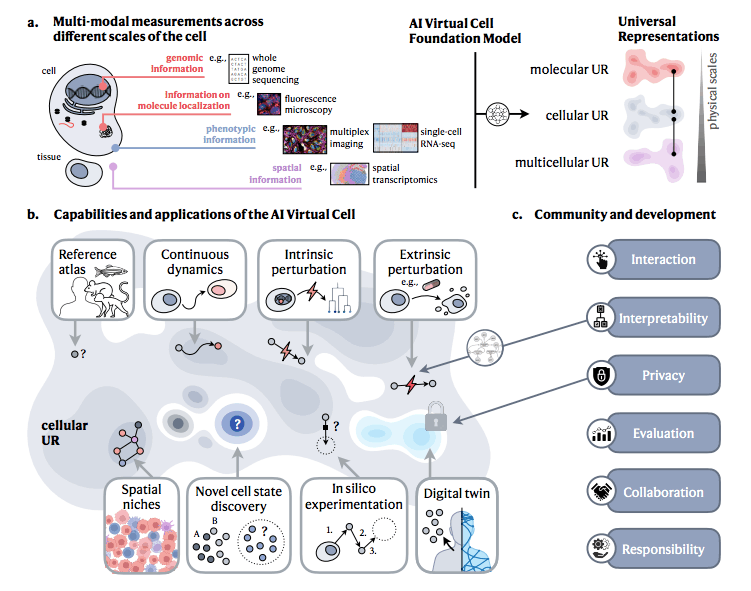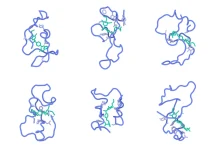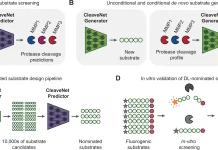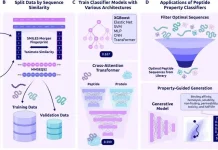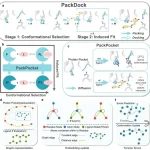One of the most important concepts in biology is the cell, which is perhaps the smallest unit of life. This understanding and identifying the underlying causes of the disease depend on accurate cell modeling. New possibilities for modeling cells are presented by recent developments in artificial intelligence (AI) and the capacity to produce massive amounts of experimentation data. Here, researchers describe a concept for AI-powered virtual cells in which expanding biological data across measures and sizes is used to directly learn realistic representations of cells and cellular systems under various circumstances. By predicting and comprehending the behavior of real cells, virtual tools are being utilized to create representations that are universal across scales. With the promise of broad applicability and biological correctness, this technology is being developed to enable interpretable in-silico studies. With its ability to predict cellular responses to perturbations, discover new therapeutic targets, and investigate large-scale hypothesis exploration, AI Virtual Cells have a bright future. Collaborations in open science spanning the fields of academia, charity, biopharma, and artificial intelligence are critical to this progress.
Introduction
The basic building block of life, the cell, is a marvelously complex creature whose traits and behaviors defy the capabilities of computational and physical modeling.
Complex behavior in every cell arises from a multitude of chemical interactions, making it a dynamic and adaptive system. Certain elements exhibit remarkable resilience to various perturbations, such as the removal of genes or their substitution with homologs from distinct species. Conversely, other elements are susceptible to even tiny disturbances, such as a point mutation or an external stimulus that causes cells to malfunction and develop illness.
Virtual cell models are being created by scientists to better comprehend the behavior and biological processes of individual cells. These computer models simulate the biological processes and interactions of a cell. Rule-based models frequently rely on computational or mathematical techniques such as stochastic simulations, differential equations, or agent-based models. Transcriptional and translation processes, cytoskeletally mediated cell behavior, biochemical networks, and metabolic flux are just a few of the cell biology topics they cover. Mycobacterium genitalium 482 genes and molecular functions were modeled in the first whole-cell model, which was created in 2012. Several bacterial species have since been represented using genome-wide models that have been constructed.
Drawback of Previous Modelling Methods
Multi-scale modeling: Cells function on a variety of scales in space and time, ranging from the atomic to the molecular to the cellular and histological, with nonlinear transformations between scales revealing functional characteristics.
A vast number of involved components and interactions, together with diverse processes: Gene regulation, metabolic pathways, and signal transduction, are just a few of the interconnected systems that make up cellular functioning. Biomolecular species in a variety of dynamic configurations and states are involved in each activity in enormous numbers.
Nonlinear dynamics: A large number of biological systems exhibit high levels of nonlinearity, meaning that subtle alterations in inputs can result in intricate modifications in outputs. Therefore, these elements, taken together, provide a significant barrier to the development of a virtual cell, even in the face of advancements in the modeling of individual cellular functions.
Advances in AI
The development of cell models that are directly learned from massive amounts of data has been made possible by the fascinating advances in ‘omics and artificial intelligence. This offers an opportunity for an artificial intelligence virtual cell (AIVC), a massive neural network-based model that can replicate and reflect the behavior of molecules, cells, and tissues in a variety of states. AIVC is multi-scale and multi-modal. Large reference datasets have been gathered as a result of the exponential growth in measurement technologies; for several years, data has doubled every six months. Artificial intelligence (AI) has improved the capacity to derive patterns and processes directly from data, which makes it predictive, generative, and queryable—all of which are critical for biological study and comprehension.
Looking Into AI Virtual Cell
AI Virtual Cell is a learned simulator of cells and cellular systems in a variety of realistic settings, including environmental factors, disease states, differentiation phases, perturbations, and stochastic fluctuations. In this situation, a virtual cell should incorporate extensive knowledge of cell biology. In addition to helping to uncover the programming language of cellular systems and providing an interface for use in engineering, virtual cells must function across biological sizes, over time, and across data modalities.
An AI virtual cell should, in particular, be able to do the following tasks for researchers:
- Generate a universal representation of biological states across species, modalities, datasets, and contexts;
- Predict cellular function, behavior, and dynamics, as well as identify the underlying mechanisms;
- Conduct in silico experiments to produce and test new scientific hypotheses and direct data collection to expand the virtual cell’s capabilities effectively.
Aim of the Study
The study’s goal is to jumpstart the creation of a cooperative research agenda for a comprehensive, long-term project that includes a roadmap for the development, implementation, and deployment of artificial intelligence virtual cells.
- Researchers discuss the latest developments in artificial intelligence (AI) in cell biology and how they can be used to create virtual versions of cells.
- Researchers discuss the opportunities and priorities in data generation, AI models, benchmarking, interpretation, and guaranteeing the safety and integrity of biological information.
- Scientists propose that a thorough understanding of cellular mechanisms is attainable by promoting interdisciplinary cooperation in open science across academia, charity, and the biopharma and AI businesses. In order to support upcoming advances in programmable biology, drug discovery, and personalized treatment, AI Virtual Cells have the potential to transform science as researchers know it, advance the grasp of novel biological principles, and enhance human intellect.
Conclusion
An AI virtual cell should usher in a new era of biological simulation, wherein biologists studying cancer will be able to model how particular mutations cause cells to turn from healthy to malignant; biologists studying development will be able to predict how developmental lineages evolve in response to perturbations in particular progenitor cells; and microbiologists studying viruses will be able to predict how infection will affect both the infected cell and its host organism. By revolutionizing the methods used to create and rank hypotheses, these models will empower both theorists and experimentalists by enabling biologists to work across a vastly expanded scope that more closely matches the huge scales of biology. It will significantly reduce the search space for mechanistic ideas, speeding up the identification of fundamental factors underlying cellular function, even though it may not always explicitly find mechanistic linkages.
Article Source: Reference Paper
Important Note: arXiv releases preprints that have not yet undergone peer review. As a result, it is important to note that these papers should not be considered conclusive evidence, nor should they be used to direct clinical practice or influence health-related behavior. It is also important to understand that the information presented in these papers is not yet considered established or confirmed.
Follow Us!
Learn More:
Deotima is a consulting scientific content writing intern at CBIRT. Currently she's pursuing Master's in Bioinformatics at Maulana Abul Kalam Azad University of Technology. As an emerging scientific writer, she is eager to apply her expertise in making intricate scientific concepts comprehensible to individuals from diverse backgrounds. Deotima harbors a particular passion for Structural Bioinformatics and Molecular Dynamics.

